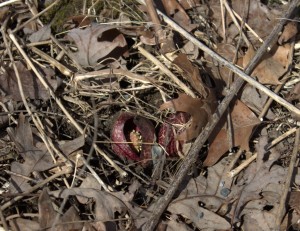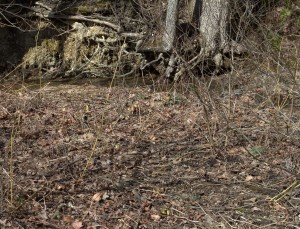The First Flower of Spring Award goes to… Skunk Cabbage!
Looking back on my old posts here at wildeherb, it seems I’m so excited for Spring to arrive that every year I just have to get out and see the skunk cabbage.

That may be because it’s our first flower of spring, but also it’s an oddity. I favor the ends of the diversity rainbow and the skunk cabbage is a special one.
It doesn’t matter if you’re talking about the Eastern or Western Skunk Cabbage, they are both strange and beautiful at the same time.
Their growth habit isn’t like a typical flower you might think of where some green leaves develop first and a bit later flowers with pretty petals appear near the top of the plant or the tips of the branches. Skunk cabbage forms the flowering structure first, then the leaves appear.
Skunk cabbage, Symplocarpus foetidus, is in the Arum Family, Araceae. Other family members are odd in their growth habit too, like the Jack-in-the-Pulpit that we find in similar habitats as the skunk cabbage.
The general form of the skunk cabbage flowering structure has two parts known as the spadix and spathe. To save a thousand words, here’s a close-up picture of the plant shown above with a few leaves cleared away.

The spadix is the flowering structure that holds the actual flowers. The spathe is a hood-like structure that at least partially envelopes the spadix. Here, the spathe is maroon flecked with yellow.
In Eastern Skunk Cabbage the spathe may completely surround the spadix except for leaving a small opening to allow pollinators inside and for letting its stinky attractant to be released. Its spadix is round.
The flowers don’t really look like such as there are no petals. But, if you zoom in close you can see the pollen-laden stamens sticking up a couple of millimeters.
One thing to realize about this woodland plant is that it’s very cryptic at this time of the year. You can’t just scan an area quickly and hope to see their little hoods sticking up. They blend into the environment quite well. In the photo below there are 22 (or more!) skunk cabbage spathes. Good luck finding them all.

(Photos taken 3 March 2016 in Juniata County, PA. Click on any image to see a larger view.)
When the leaves roll out and gain some size it will be easy to find the plants. The spathes that lie at the base of the leaves will be overshadowed as they die back.
If you don’t know where to go to see this interesting plant, look for it near woodland streams, in soggy ground and wetlands. In our area a public place to find them is the Day Use Area of Little Buffalo Park. You have about a month to see the skunk cabbage there, so plan a visit soon.